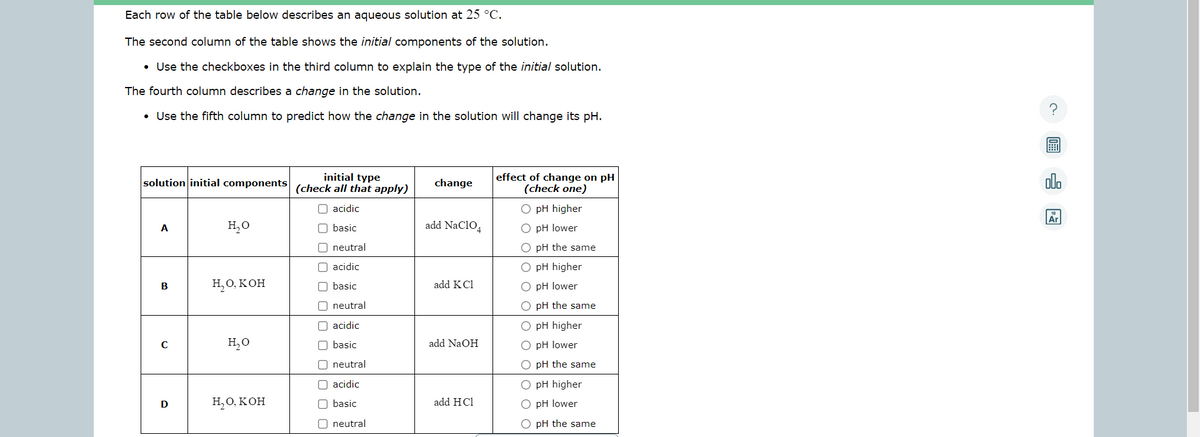Each row of the table below describes an aqueous solution at 25 °C. The second column of the table shows the initial components of the solution. • Use the checkboxes in the third column to explain the type of the initial solution. The fourth column describes a change in the solution. • Use the fifth column to predict how the change in the solution will change its pH. solution initial components (check all that apply) initial type acidic basic neutral acidic basic neutral A B с D H₂O H₂O. KOH H₂O H₂O, KOH O acidic basic neutral acidic basic neutral change add NaClO₂ add KCI add NaOH add HCl effect of change on pH (check one) O pH higher O pH lower O pH the same O pH higher O pH lower O pH the same O pH higher O pH lower O pH the same O pH higher pH lower pH the same
Each row of the table below describes an aqueous solution at 25 °C. The second column of the table shows the initial components of the solution. • Use the checkboxes in the third column to explain the type of the initial solution. The fourth column describes a change in the solution. • Use the fifth column to predict how the change in the solution will change its pH. solution initial components (check all that apply) initial type acidic basic neutral acidic basic neutral A B с D H₂O H₂O. KOH H₂O H₂O, KOH O acidic basic neutral acidic basic neutral change add NaClO₂ add KCI add NaOH add HCl effect of change on pH (check one) O pH higher O pH lower O pH the same O pH higher O pH lower O pH the same O pH higher O pH lower O pH the same O pH higher pH lower pH the same
Chapter9: Acids, Bases, And Salts
Section: Chapter Questions
Problem 9.108E
Related questions
Question

Transcribed Image Text:Each row of the table below describes an aqueous solution at 25 °C.
The second column of the table shows the initial components of the solution.
• Use the checkboxes in the third column to explain the type of the initial solution.
The fourth column describes a change in the solution.
• Use the fifth column to predict how the change in the solution will change its pH.
initial type
solution initial components (check all that apply)
O acidic
A
B
с
D
H₂O
H₂O, KOH
H₂O
H₂O, KOH
basic
neutral
acidic
basic
neutral
acidic
basic
neutral
acidic
basic
☐ neutral
00
change
add NaC104
add KC1
add NaOH
add HCl
effect of change on pH
(check one)
O pH higher
O pH lower
O pH the same
O pH higher
O pH lower
O pH the same
O pH higher
O pH lower
O pH the same
O pH higher
O pH lower
O pH the same
?
olo
Ar
Expert Solution
This question has been solved!
Explore an expertly crafted, step-by-step solution for a thorough understanding of key concepts.
Step by step
Solved in 5 steps

Follow-up Questions
Read through expert solutions to related follow-up questions below.
Follow-up Question

Transcribed Image Text:Suppose a 250. mL flask is filled with 1.6 mol of NO and 1.2 mol of NO₂. The following reaction becomes possible:
NO₂(g) + NO(g) → 2NO₂(g)
The equilibrium constant K for this reaction is 0.670 at the temperature of the flask.
Calculate the equilibrium molarity of NO. Round your answer to two decimal places.
OM
X
Solution
Knowledge Booster
Learn more about
Need a deep-dive on the concept behind this application? Look no further. Learn more about this topic, chemistry and related others by exploring similar questions and additional content below.Recommended textbooks for you


Chemistry
Chemistry
ISBN:
9781305957404
Author:
Steven S. Zumdahl, Susan A. Zumdahl, Donald J. DeCoste
Publisher:
Cengage Learning

Chemistry: An Atoms First Approach
Chemistry
ISBN:
9781305079243
Author:
Steven S. Zumdahl, Susan A. Zumdahl
Publisher:
Cengage Learning


Chemistry
Chemistry
ISBN:
9781305957404
Author:
Steven S. Zumdahl, Susan A. Zumdahl, Donald J. DeCoste
Publisher:
Cengage Learning

Chemistry: An Atoms First Approach
Chemistry
ISBN:
9781305079243
Author:
Steven S. Zumdahl, Susan A. Zumdahl
Publisher:
Cengage Learning


Principles of Modern Chemistry
Chemistry
ISBN:
9781305079113
Author:
David W. Oxtoby, H. Pat Gillis, Laurie J. Butler
Publisher:
Cengage Learning

Chemistry & Chemical Reactivity
Chemistry
ISBN:
9781337399074
Author:
John C. Kotz, Paul M. Treichel, John Townsend, David Treichel
Publisher:
Cengage Learning